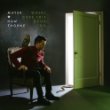In the music biz, it’s always hard to know where to go next. The evolving genres definitely create new opportunities to experiment, but when you’re listening to the fans, the critics, the labels…things tend to get really sloppy. On his first two albums, Mayer Hawthorne appeared content with digging into his smart war chest of nostalgia, even if he had been ruthlessly branded as the pale imitation of yesterday’s soul heroes. But, timing is everything and it proved to be vital for the Ann Harbor, Michigan native, who formally spun records as a DJ prior to his debut as a singer. He jumped on the soul revival train right when Raphael Saadiq, Cee Lo Green, Bruno Mars and R. Kelly were seizing the opportunity. Then all of a sudden, the bulk of black music critics and those who can’t imagine “Doobiein’ your funk” found any kind of way not to like the guy.
On Hawthorne’s third solo record, Where Does This Door Go, it now seems that he’s entertaining the conversations of the online chatter and those who don’t feel he’s “black” enough. If that is not the rationale behind Hawthorne’s radical shift, his latest effort indicates that he certainly appears to be getting tired of rehashing the same ol’ “blued-eyed soul” and wants to broaden his musical landscape. As if he’s been bitten by the alt-R&B bug, Hawthorne finds a clever blend of Questlove swagger and 21st century twists to sound more contemporary, vibrant and youthful.
Throughout Where Does This Door Go, Hawthorne takes off some of the aging wrinkles that come with singing Philly soul ballads and Motown throwbacks. And although you can still hear classic Hawthorne inside the mix, tracks like “Her Favorite Song,” “The Innocent” and the Steely Dan-sounding “The Stars Are Ours” feel fuller with sound and do their best to overshadow any of his vocal weaknesses. Even “Crime,” which sports a mesh of Indian sitar and sophisticated synths attached to a sexy John Legend balladry and a remarkable Kendrick Lamar guest spot, feels like a leap forward artistically for Hawthorne. Add in the occasional 10-second interludes scattered throughout the disc and one can quickly discern that Hawthorne is trying to shed some of his old skin.
It’s important to note that the album gem, “Reach Out Richard,” produced by Pharrell Williams, plays with the finest in Hawthorne’s bag of tricks by absorbing smart hooks that seem so familiar. To some it feels hip and new (at least when viewing it with Justin Timberlake’s 20/20 vision), but most will view it as a careful glance at ‘70s radio gold. It’s also a maturing step up in the lyricism department, as he sidesteps briefly from the role of romantic crooner to produce a letter of ease for a concerned father: “I’ve got to live and learn/The kid’s alright/I know that you will see/The kid’s alright/I’ll find my way eventually.”
What might be the hardest bit to chew from Where Does This Door Go is the sheer abandonment of the throwback soul. There are places on the album where he tries to remind you what he’s known for, like the intimate closer “All Better” (which sounds like it’s been influenced by Lennon’s “Imagine”) and the EW&F-teased “Back Seat Lover,” but there’s simply not enough of that. This disc will probably alienate the traditional soul demographic, and that’s probably just fine for him. It appears this album was strategically designed to do that, or rather reach out to a newer, different one. In most places, he succeeds in converting the old to the new. Plus, evidence of this change lies in the revelatory album title. But, damn, why did he have to abandon ship so soon? I actually liked the old school throwbacks. Recommended.
By J Matthew Cobb

